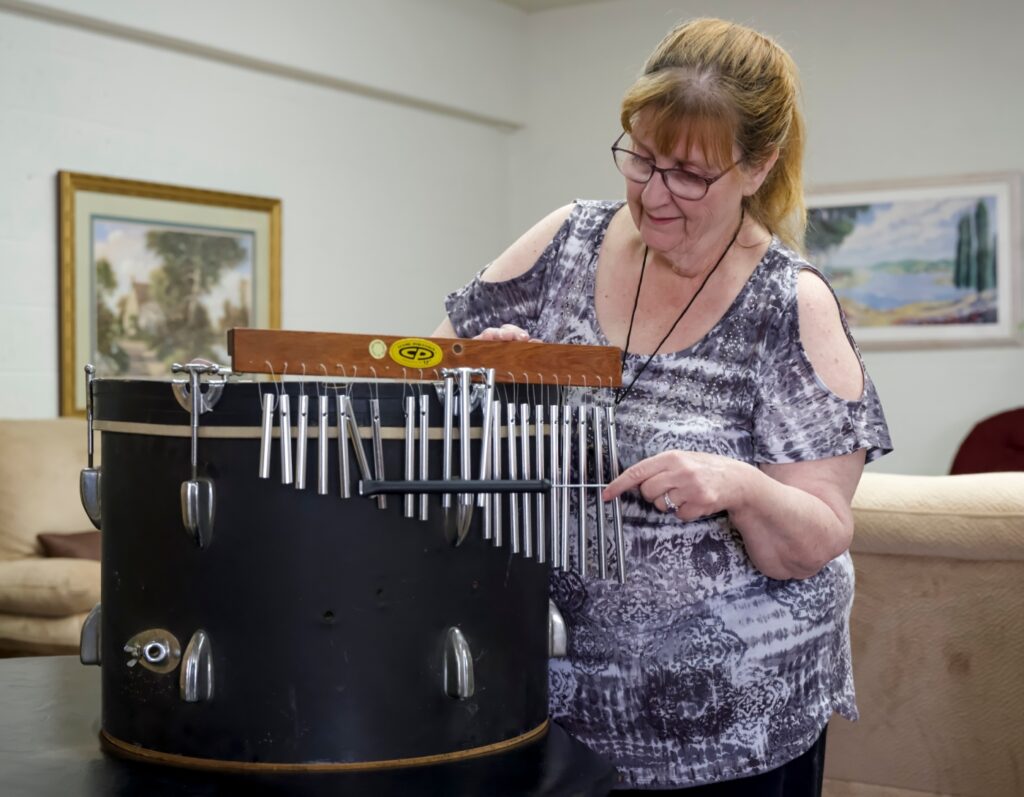
We at the Globe are proud to announce that the newspaper will get a new purpose this month.
No, not at the bottom of a bird cage or in a kitty litter box.
Rather, the Globe will have a starring role (sort of) in the Old Pros’ live radio play version of the 1940s classic holiday movie, “It’s a Wonderful Life,” where it will be used as a stage prop, or more precisely a sound maker. Think old-time radio shows and sound effects.
Sound guy Mark Rabinowitch — yes, that guy who takes photos for the Globe — will thwack a folded copy of the newspaper on a table to make a sound like someone thwacking a folded news paper on a table. (Try it, you’ll hear what we mean.)
“It’s called for in the script,” Rabinowitch explained at a recent rehearsal of the radio play, just before he thwacked the paper on the table.
In fact, that sound will come in the play when George Bailey’s Uncle Billy thwacks the paper in annoyance over the villainous robber baron Mr. Potter (thereby losing $8,000).
(In case you’re wondering, Rabinowitch was using the Oct. 21 issue of the Globe, with a story about the Laguna Playhouse on the cover.)
Next, Rabinowitch held up a plastic sandwich bag filled with colorful peanut M&Ms. Soon he would be dropping those peanut M&Ms into a plastic pill bottle to make the sound of — you guessed it — pills dropping into a plastic pill bottle.
That sound will come when the town druggist fills a prescription, but accidentally puts poisoned pills in the bottle and, well, we don’t want to give away the rest.
The creation of these sound effects using everyday objects is called Foley art. The name comes from Jack Foley, who was said to be the father of this art.
Foley worked with Universal Studios at the beginning of the 20th century, when Hollywood studios were switching from silent films to “talkies.” The movie makers realized that the microphones had a hard time picking up some background sounds, so they had to be reproduced and added later.
Rabinowitch learned the art from the late Village resident Johnny Leveque, a sound editor who won two BAFTAs (that’s the British Oscars) and was nominated for four Academy Awards for best sound editing. The Old Pros’ production is dedicated to Leveque.
“We met at a rehearsal. Johnny was doing the Foley,” Rabinowitch recalled. “He and I started talking, and he literally pointed at me and said, ‘You, you are gonna work with me on the Foleys.’ And I didn’t even know what that was.
“After the rehearsal, he dragged me to Home Depot and we walked around for an hour, and he kept banging on things to see what noises different things would make.”
After that, Rabinowitch was sold on the art of the Foley.
In the Old Pros radio play, Sharone Rosen (the renowned Village singer) will be helping Rabinowitch create the sound effects.
Rosen has the arguably enviable job of creating the sound that heralds the descent of the angel Clarence from heaven to Earth — that would be the otherworldly tinkle of a bell tree.
“I think that is my favorite sound effect,” Rosen said. “It is a series of small chimes, often heard in 1980s ballads. I think I use them about seven times.”
During the rehearsal, Rosen also demonstrated how she recreates the sound of footsteps by banging two rubber sandals together. A big clap of the hands becomes the sound of an ear being boxed (the ear of poor George). The clamoring of a large spaghetti pot with lid creates the sound of Uncle Billy knocking over trash cans. And a tiny wooden door with bells is opened and shut to signal comings and goings.
“I’m also rather fond of punching a leather pillow to simulate the sound of someone getting socked on the jaw,” Rosen said.
The table at the rehearsal was cluttered with other objects: a baking pan that will be filled with corn flakes and stomped on to create the sound of footsteps in the snow, and a bucket of water that will have a rock or two dropped into it when a character falls through the ice on a pond.
There was also a real train whistle, an old corded telephone, empty cans of cream of chicken soup, a blue Christmas bell from 1977, stacked coins, and an empty wine bottle and wine glass (to make the sound of broken glass). A wind machine will create the sound of howling wind.
All these sound effects will be created by Rabinowitch and Rosen on stage, from a table that will have a prominent position next to the actors performing the characters’ dialogue.
In fact, the playwright of the original manuscript of the radio play of “It’s a Wonderful Life” stipulates that the sound effects be created in full view of the audience.
“The real visual drama for the on-site audience is in watching the sound effects crew,” says the manuscript by playwright Philip Grecian. “Make sure they, and their various apparatuses, are clearly seen.”
Carol Glenn is directing the Old Pros’ radio play.
“A great deal of the fun for the audience is watching the sound effects being produced,” she noted.
One sound effect that won’t be created by Rabinowitch and Rosen: the sound of audience members clapping.
They’ll be told precisely when to clap: Diane Johanson will walk across the stage carrying a large sign that says “Applause.”
